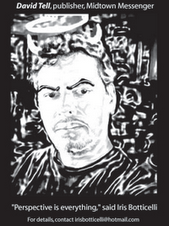We ordinarily would wait a week or two following its cover date to post a story from our print edition. But rather than get scooped, and since, delivery personnel being out of town, the bulk distribution of the paper may be a little late this month, here's the breaking news—already a couple weeks old, actually, as of the posting date—but as far as we know, it hasn't been carried elsewhere ... yet.
Midtowner to vie in Dist. 7
Seeking Council seat when Lingner exits, Marston cites big credentials
By David Tell, Messenger editor
In a field that is growing almost as crowded as the race for the Democratic nomination for president, one of Midtown’s own has thrown her hat in the ring to succeed Doug Lingner on City Council in District 7.
Ruth Ann Marston is a longtime Willo resident and educator who retired from the Phoenix Elementary School District No. 1 a few years ago. She is now in her second term on its governing board, as its president. She also leads the loosely organized Phoenix Historic Neighborhoods Coalition, as well as serving as president of the Central Arizona Chapter of the Arizona Historical Society. Supplicants for rezonings and their opponents also are familiar with her reasoned statements and actions as part of the Encanto Village Planning Committee, of which she is a past chair.
While all these offices and accomplishments position her well for support from within the urban-historic end of District 7, Marston acknowledges that a key task will be introducing herself to residents and organizations in the bulk of the district, which wends through southwest Phoenix.
Despite the fact that Midtown’s historic neighborhoods represent only a small portion of District 7 both geographically and demographically, Councilman Doug Lingner has been a staunch supporter of historic neighborhood and preservation issues. Election of Marston could be expected to only enlarge that support and awareness.
To get acquainted with the rest of the district, “I plan to do a lot of walking and meeting people,” Marston said. But she said she’s not unknown in the southwest part of the city. “I have contacts in the west and southwest valley through the work on the planning committee where I’ve been a member for 10 years. So I’ve been active in planning and zoning issues, particularly when people have tried to break zoning rules, or go around the system so zoning was not predictable—and when they take opportunities for personal self-aggrandizement instead of helping the whole valley develop.”
As an example, “I was active keeping people from building very dense developments around 75th Avenue and I-10. Light rail is going in there and there will be a park and ride lot. Developers were planning to break through the industrial zoning south of the freeway to build very dense industrial housing in areas that would be surrounded by big trucks,” Marston said. She pointed out that seven of the city’s 15 or so village planning subunits are in whole or part in District 7; thus the district’s representative’s reach and sphere of concern is quite broad, in virtue of his or her role in making appointments to the respective planning committees.
She added her service on the school board gives her contacts in school systems throughout the valley.
As for reaching out to the Hispanic constituents in the district, “I’ve taken Spanish classes”; she speaks “porquito, no mas.” She said she spoke Spanish more fluently when she was a school principal and the skill was called upon more often.
Marston said the idea of running for Council had “been growing on me as I’ve watched the city become interested in reinventing itself through education. I’m a lifelong educator. I can see that there are gaps in the city’s effort. Having the university downtown is great, but unless the rest of the educational system support it and kids come to those programs ready, it will be less effective. Having children come from somewhere else is not as useful to Phoenix.”
Marston said access to downtown schools by the city’s own residents involves “being prepared to be successful, and second, to be able to afford to be successful,” she said. “There are a lot of kids in the downtown area whose parents can’t support them through college, they’re going to need ways to work their way through and I don’t think we’ve addressed that adequately.”
Would the inevitable attention to additional city and constituent concerns dilute Marston’s ability to serve the historic end of the district and its issues? “I don’t think it’s a question of dilution. I think things are complementary,” she said. “The historic district supports the whole culture of the city of Phoenix. It’s very important to preserve the historic area itself. Just having a bunch of people living in proximity doesn’t constitute a city. A city is the sum of the past and its future aspirations. It’s important to know what we’ve been in order to build on it. It is absolutely true that you’re doomed to repeat the past if you forget it.
“People don’t move to Phoenix because there’s a lot of dirt,” Marston said, acknowledging that it’s partly the climate that draws them. But they also move here “because of the ambiance, the way they’re treated and opportunities that are available. The opportunities are largely due to foresight of people in the past, on, for example, water conservation and infrastructure. You can move your car in Phoenix, not like LA or Chicago. People have thought ahead in terms of larger infrastructure and we need to continue to think ahead, have that kind of foresight.”
At the same time, “Phoenix needs to be developed for livability, for sustainable growth—and not only for immediate profitability,” she said. “What really needs to happen—I’m a great believer in collective wisdom. We need to have substantial agreement about how Phoenix will grow. It needs to be detailed, especially at the neighborhood and village level. We have to insist on it. We can’t let [personal] gain on the part of an individual or group change the opportunity for sustained livable growth.”
In a field in which other contenders have already announced and in some cases garnered important endorsements, how does Marston see her chances? She points to her two wins in school board elections: “In 2002, I got 38.24 percent of the vote in a field of five candidates and two write-ins, in a vote-for-two situation. For ’06, I got 44.2 percent of the vote in field of three. You know how hard school board races can be fought. Knowing that you have a chance of winning is part of the thing about making your decision about whether to run.”
Marston also said she was more inclined to run when attorney Harry Keidan agreed to be her campaign manager. She said as she is a Republican and he’s a Democrat, that broadens her outreach to the district's voters and people of influence.
Given that Council races are officially nonpartisan, and the rest of her record and profile, she doesn’t expect party affiliation to be a factor overall, nor as to her support within Midtown, where the voter registration tilts slightly Democratic, unlike most of the state. She says she became a Republican during Sen. Barry Goldwater’s heyday, and has toyed with switching parties, as District 4 Councilman Tom Simplot recently did following the November elections. “Many of us are questioning our party affiliation, because it doesn’t mean what it did when we registered,” she said. But she resists switching camps at the moment, acknowledging it would be seen as patently opportunistic. “It would be obviously self-serving. The only reason at this time would be the candidacy, and no one would believe it” to be motivated by principle. She said party registration aside, Midtown “doesn’t’ necessarily vote Democratic. It shouldn’t be a disadvantage.”
Others who have thrown their hats in the District 7 ring include Michael Nowakowski, Laura Pastor, Dustin Steiger, Santos Chavez and Troy Price. Look for coverage later in the campaign season that provides more information on all the viable candidates.
Thursday, February 15, 2007
Subscribe to:
Post Comments (Atom)



No comments:
Post a Comment